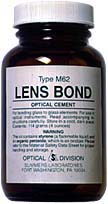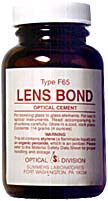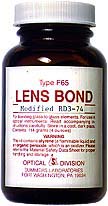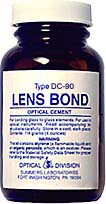

|
||||||||||||||||||||||||||||||||||||||||||||||||||||||||||||||||||||||||||||||||||||||||||||||||||||||||||||||||||||||||||||||||||||||||||||||||||||||||||||||||||||||||||||||||||||||||||||||||||||||||||||||||||||||||||||||||||||||||||||||
12000 |
Lens Bond Type C-59, |
4oz |
$52.90 |
|
13000 |
Additional Catalyst |
3cc |
$13.80 |
|
13003 |
Thinner (Monomeric styrene) |
4oz |
$13.80 |
|
13004 |
Plasticizer Modifications |
.5-5% |
$9.20 |
|
13008-A |
Refractive Index Adjuster |
5gr |
$20.00 |
|
Room Temperature |
Oven Temperature |
|||
|
Catalyst Ratio |
Pre-Cure |
Full-Cure |
Pre-Cure |
Full-Cure |
|
2:100 |
24 hours |
6 days |
45 minutes |
2 hours |
|
3:100 |
18 hours |
4 days |
30 minutes |
1.5 hours |
|
5:100 |
12 hours |
3 days |
22 minutes |
1 hour |
| NOTE: Sufficient catalyst is supplied with each bottle of cement. The catalyst ratio shown at the top is recommended as standard. Changes in the ratio shown will alter the curing times shown, i.e., cure rate can be accelerated slightly by increasing the catalyst. | ||||
1. Preparation of Elements: Other than normal cleaning procedures, no special preparation is required. The best final cleaner is reagent grade or C.P. acetone.
2. Preparation of Cement: Prepare Type C-59 by the addition of catalyst to cement in a clear glass container. Thorough mixing is important. While stirring, hold container up to the light and observe the Schlieren Effect. When the Schlieren Effect disappears, continue mixing for at least 30 seconds. The entrapped air in the cement will surface if the mixture rests at room temperature for a short time, or is briefly subjected to a vacuum of 625mm Hg. (25" Hg.) The catalyst bottles have a specially designed controlled-drop tip, pre- calibrated at our laboratory to an accuracy of ±1%. To use, squeeze the inverted bottle, allowing one drop to fall at a time. For 2:100 mixture, use 2 drops per 3ml. of cement. For 5:100 mixture, use 5 drops per 3ml of cement. (or 8 to 5ml or 40 to 25ml).
N.B. The catalyst bottle supplied with Type C-59 Cement contains more than sufficient catalyst for a 3:100 catalyst:cement ratio.
Safety: Although LENS BOND is quite safe to use, some persons may be sensitive to the chemicals comprising the formulation. For them, the use of finger cots or gloves is recommended. Adequate ventilation should be provided.
3. Application and Curing of Type C-59: Place the prepared LENS BOND on the concave surface, and place the convex surface thereon. Press down firmly and gently until LENS BOND completely wets the matching surfaces. Then, with a slow rotary motion and light pressure, force air bubbles from between the lenses. Excess Cement can be removed with a cloth slightly moistened with alcohol or acetone. (Excess solvent will remove cement from between the cemented components.) After pre-cure, holding devices can be removed and the components carefully cleaned. Before environmental testing, however, the lenses must be fully cured.
Full-cure time is in addition to the pre-cure time. If there is no reason to remove holding devices after pre-cure, components should be cured for the total time (pre-cure plus full-cure). If there is any doubt about cure being achieved, allow components to cure for a longer period of time. The Cement will not overcure. If cure is not achieved in a reasonable amount of time, the catalyst ratio, mixing procedure, and temperature should be checked.
Note: If the elements will undergo hostile environmental tests, allow 48 to 72 hours between full-cure and testing.
Viscosity........................275 cps. to 320 cps. Refractive Index (full-cured)....1.55 at 25°C Refractive Index (uncured).......1.53 Operational Temperature Range....-54°C (-65°F) to 100°C(212°F) Youngs Modulus...................6.2 x 105lbs/in2 Shear Strength...................5200 lbs/in2 Impact...........................(.3 to .4)ft lb/in Specific Heat....................(.2 to .4) Cal/gm Dielectric Constant..............3 at 106cps Loss Factor at 106 cps...........(.05) Water Absorption.................0.3% (24 hours. 25°C on bulk material) Dispersion Formula...............n=1.5754-(0.04742)-[0.0070/(
2-0.028)]+
[0.0011/(2-0.028)2] Shrinkage on Cure................Approximately 4% pH...............................3.2 Specific Gravity.................1.22 Shore D. Hardness................Approximately 90 Surface Tension..................44 Dynes/cm. Linear Coefficient of Expansion..Approximately 6.3x10-5/°C @ between 27°C-100°C 5.58x10-5/°C @ between 100°C-200°C Thermal Conductivity.............500x10-6 cal(sec)(sq.cm)(°C)(cm) Flash Point (uncured)............50°C Glass Transition (Tg)............>90°C Outgassing TML...................2.9% Outgassing CVCM..................0.1% Shipping and Storage.............Type C-59 needs no special handling or storage. It should, however, be kept away from intense light and elevated temperatures. Shelf Life.......................18 months from date of manufacture Size.............................(4oz) 114 gm
*The reference index may be increased to 1.59-1.61 with the use of our Cat# 13008, - Refractive Index Adjuster For technical data on adhesion properties, solvent and thermal resistance as well as transmission studies, please go to our technical data section on this site.
 TYPE M-62
TYPE M-62Because of its 1 hour oven cure at 70°C, Type M-62 is used by companies
cementing large quantities of optical elements, and with its 4 hour room
temperature pre-cure, the use of Type M-62 permits the technician to mix
a quantity of cement and bond many elements before the cement starts to
gel. This cement is qualified to meet MIL-A-3920.
12100 |
Lens Bond Type M-62 |
4oz |
$52.90 |
|
13000 |
Additional Catalyst |
3cc |
$13.80 |
|
13003 |
Thinner (Monomeric styrene) |
4oz |
$13.80 |
|
13004 |
Plasticizer Modifications |
.5-5% |
$9.20 |
|
13008-A |
*Refractive Index Adjuster |
5gr |
$20.00 |
| Room Temperature 22°(72°F) |
Oven Temperature 70°(160°F) |
|||
|---|---|---|---|---|
|
Catalyst Ratio |
Pre-Cure | Full-Cure | Pre-Cure | Full-Cure |
| 2:100 | 4 hours | 4 days | 20 minutes | 1 hours |
| 3:100 | 3 hours | 3 days | 15 minutes | 45 minutes |
| 5:100 | 2 hours | 2 days | 10 minutes | 30 minutes |
| NOTE: Sufficient catalyst is supplied with each bottle of cement. The catalyst ratio shown at the top is recommended as standard. Changes in the ratio shown will alter the curing times shown, i.e., cure rate can be accelerated slightly by increasing the catalyst. | ||||
1. Preparation of Elements: Other than normal cleaning procedures, no special preparation is required. The best final cleaner is reagent grade or C.P. acetone.
2. Preparation of Cement: Prepare Type M-62 by the addition of catalyst to cement in a clear glass container. Thorough mixing is important. While stirring, hold container up to the light and observe the Schlieren Effect. When the Schlieren Effect disappears, continue mixing for at least 30 seconds. The entrapped air in the cement will surface if the mixture rests at room temperature for a short time, or is briefly subjected to a vacuum of 625mm Hg. (25" Hg.) The catalyst bottles have a specially designed controlled-drop tip, pre-calibrated at our laboratory to an accuracy of ± 1%. To use, squeeze the inverted bottle, allowing one drop to fall at a time. For 2:100 mixture, use 2 drops per 3ml. of cement. For 5:100 mixture, use 5 drops per 3ml of cement. (or 8 to 5ml or 40 to 25ml).
N.B. The catalyst bottle supplied with Type M-62 Cement contains more than sufficient catalyst for a 3:100 catalyst:cement ratio.
Safety: Although LENS BOND is quite safe to use, some persons may be sensitive to the chemicals comprising the formulation. For them, the use of finger cots or gloves is recommended. Adequate ventilation should be provided.
3. Application and Curing of Type M-62: Place the prepared LENS BOND on the concave surface, and place the convex surface thereon. Press down firmly and gently until LENS BOND completely wets the matching surfaces. Then, with a slow rotary motion and light pressure, force air bubbles from between the lenses. Excess Cement can be removed with a cloth slightly moistened with alcohol or acetone. (Excess solvent will remove cement from between the cemented components.) After pre-cure, holding devices can be removed and the components carefully cleaned. Before environmental testing, however, the lenses must be fully cured.
Full-cure time is in addition to the pre-cure time. If there is no reason to remove holding devices after pre-cure, components should be cured for the total time (pre-cure plus full-cure). If there is any doubt about cure being achieved, allow components to cure for a longer period of time. The Cement will not overcure. If cure is not achieved in a reasonable amount of time, the catalyst ratio, mixing procedure, and temperature should be checked.
Note: If the elements will undergo hostile environmental tests, allow 48 to 72 hours between full-cure and testing.
Viscosity........................275 cps. to 320 cps. Refractive Index (full-cured)....1.55 at 25°C Refractive Index (uncured).......1.53 Operational Temperature Range....-54°(-65°F) to 100°C(212°F) Youngs Modulus...................6.2 x 105lbs/in2 Shear Strength...................5200 lbs/in2 Impact...........................(.3 to .4)ft lb/in Specific Heat....................(.2 to .4) Cal/gm Dielectric Constant..............3 at 106 cps Loss Factor at 106 cps...........(.05) Water Absorption.................0.3% (24 hours. 25°C on bulk material) Dispersion Formula...............n=1.5754-(0.04742)-[0.0070/(
2-0.028)]+
[0.0011/(2-0.028)2] Shrinkage on Cure................Approximately 4% pH...............................3.2 Specific Gravity.................1.22 Shore D. Hardness................Approximately 90 Surface Tension..................44 Dynes/cm. Linear Coefficient of Expansion..Approximately 6.3x10-5/°@ between 27°C-100°C 5.58x10-5/°@ between 100°C-200°C Thermal Conductivity.............500x10-6 cal(sec)(sq.cm)(°C)(cm) Flash Point (uncured)............50°C Glass Transition (Tg)............>90°C Outgassing TML...................2.5% Outgassing CVCM..................0.1% Shipping and Storage.............Type M-62 needs no special handling or storage. It should, however, be kept away from intense light and elevated temperatures. Shelf Life.......................18 months from date of manufacture Size.............................114 gm(4oz)
*The reference index may be increased to 1.59-1.61 with the use of our Cat# 13008, - Refractive Index Adjuster For technical data on adhesion properties, solvent and thermal resistance as well as transmission studies, please go to our technical data section on this site.
 TYPE F-65
TYPE F-65Type F-65 was developed mainly for its rapid, room temperature cure.
With F-65, the engineer or researcher can test his systems in a few hours.
Type F-65 also saves time in pilot and small production runs, or where
curing ovens are not available. This cement is qualified to meet MIL-A-3920.
12200 |
Lens Bond Type F-65 |
4oz |
$52.90 |
|
13000 |
Additional Catalyst |
3cc |
$13.80 |
|
13003 |
Thinner (Monomeric styrene) |
4oz |
$13.80 |
|
13004 |
Plasticizer Modifications |
.5-5% |
$9.20 |
|
13008-A |
*Refractive Index Adjuster |
5gr |
$20.00 |
| Room Temperature 22°(72°F) |
Oven Temperature 70°(160°F) |
|||
|---|---|---|---|---|
| Catalyst Ratio | Pre-Cure | Full-Cure | Pre-Cure | Full-Cure |
| 2:100 | 60 minutes | 36 hours | Not Recommended | |
| 5:100 | 30 minutes | 1 day | Not Recommended | |
| NOTE: Although we do not recommend complete oven curing,
elements that have been pre-cured at room temperature for 30 minutes
can then be placed in the oven to achieve a full cure in a half hour.
The catalyst ratio shown is recommended as standard. Sufficient catalyst is supplied with each quantity. |
||||
1. Preparation of Elements: Other than normal cleaning
procedures, no special preparation is required. The best final cleaner
is reagent grade or C.P. acetone.
2. Preparation of Cement: Prepare Type F-65 by the addition
of catalyst to cement in a clear glass container. Thorough mixing is important.
While stirring, hold container up to the light and observe the Schlieren
Effect. When the Schlieren Effect disappears, continue mixing for at least
30 seconds. The entrapped air in the cement will surface if the mixture
rests at room temperature for a short time, or is briefly subjected to
a vacuum of 625mm Hg. (25" Hg.) Sufficient catalyst is supplied with
Type F-65 cement for a 5:100 ratio (5 drops per 3ml of cement).
Safety: Although LENS BOND is quite safe to use, some
persons may be sensitive to the chemicals comprising the formulation.
For them, the use of finger cots or gloves is recommended. Adequate ventilation
should be provided.
3. Application and Curing of Type F-65: Place the prepared
LENS BOND on the concave surface, and place the convex surface thereon.
Press down firmly and gently until LENS BOND completely wets the matching
surfaces. Then, with a slow rotary motion and light pressure, force air
bubbles from between the lenses. Excess Cement can be removed with a cloth
slightly moistened with alcohol or acetone. (Excess solvent will remove
cement from between the cemented components.) After pre-cure, holding
devices can be removed and the components carefully cleaned. Before environmental
testing, however, the lenses must be fully cured.
Full-cure time is in addition to the pre-cure time. If there is no reason
to remove holding devices after pre-cure, components should be cured for
the total time (pre-cure plus full-cure). If there is any doubt about
cure being achieved, allow components to cure for a longer period of time.
The Cement will not overcure. If cure is not achieved in a reasonable
amount of time, the catalyst ratio, mixing procedure, and temperature
should be checked.
Note: If the elements will undergo hostile environmental
tests, allow 48 to 72 hours between full-cure and testing.
Viscosity........................275 cps. to 320 cps. Refractive Index (full-cured)....1.55 at 25°C Refractive Index (uncured).......1.53 Operational Temperature Range....-54°C(-65°F) to 100°C(212°F) Youngs Modulus...................6.2 x 105lbs/in2 Shear Strength...................5200 lbs/in2 Impact...........................(.3 to .4)ft lb/in Specific Heat....................(.2 to .4) Cal/gm Dielectric Constant..............3 at 106 cps Loss Factor at 106 cps...........(.05) Water Absorption.................0.3% (24 hours. 25°C on bulk material) Dispersion Formula...............n=1.5754-(0.04742)-[0.0070/(
2-0.028)]+
[0.0011/(2-0.028)2] Shrinkage on Cure................Approximately 4% pH...............................3.2 Specific Gravity.................1.22 Shore D. Hardness................Approximately 90 Surface Tension..................44 Dynes/cm. Linear Coefficient of Expansion..Approximately 6.3x10-5/°C at between 27°C-100°C 5.58x10-5/°@ between 100°C-200°C Thermal Conductivity.............500x10-6 cal(sec)(sq.cm)(°C)(cm) Flash Point (uncured)............50°C Glass Transition (Tg)............>90°C Outgassing TML...................2.6% Outgassing CVCM..................0.1% Shipping and Storage.............Type F-65 needs no special handling or storage. It should, however, be kept away from intense light and elevated temperatures. Shelf Life.......................18 months from date of manufacture Size.............................114 gm(4oz)
*The reference index may be increased to 1.59-1.61 with the use of our Cat# 13008, - Refractive Index Adjuster For technical data on adhesion properties, solvent and thermal resistance as well as transmission studies, please go to our technical data section on this site.
 TYPE RD3-74
TYPE RD3-74Type RD3-74 is a modification of Type F-65 containing a plasticizer.
Because most optical cements contract upon curing, they can occasionally
set up stresses in thin elements. This stress could either cause bond
breakage or lens distortion. Type RD3-74 solves this problem by remaining
slightly elastic after curing.
12300 |
Lens Bond Type RD3-74, |
4oz |
$52.90 |
|
13000 |
Additional Catalyst |
3cc |
$13.80 |
|
13003 |
Thinner (Monomeric styrene) |
4oz |
$13.80 |
|
13004 |
Plasticizer Modifications |
.5-5% |
$9.20 |
| Room Temperature 22°(72°F) |
Oven Temperature 70°(160°F) |
|||
|---|---|---|---|---|
| Catalyst Ratio | Pre-Cure | Full-Cure | Pre-Cure | Full-Cure |
| 1:100 | 2 hours | 36 hours | Not Recommended | |
| 3:100 | 45 min. | 30 hours | Not Recommended | |
| 5:100 | 30 min. | 1 day | Not Recommended | |
| Although we do not recommend complete oven curing,
elements that have been pre-cured at room temperature for 30 minutes
can then be placed in the oven to achieve full-cure in 1/2 hour.
NOTE: Sufficient catalyst is supplied with each bottle of cement. The catalyst ratio shown at the top is recommended as standard. Changes in the ratio shown will alter the curing times shown, i.e., cure rate can be accelerated slightly by increasing the catalyst. |
||||
1. Preparation of Elements: Other than normal cleaning procedures, no special preparation is required. The best final cleaner is reagent grade or C.P. acetone.
2. Preparation of Cement: Prepare Type RD3-74 by the addition of catalyst to cement in a clear glass container. Thorough mixing is important. While stirring, hold container up to the light and observe the Schlieren Effect. When the Schlieren Effect disappears, continue mixing for at least 30 seconds. (NOTE: Only the amount of cement that can be used within pre-cure time should be prepared.) The entrapped air in the cement will surface if the mixture rests at room temperature for a short time, or is briefly subjected to a vacuum of 625mm Hg. (25" Hg.) The catalyst bottles have a specially designed controlled-drop tip, pre-calibrated at our laboratory to an accuracy of ± 1%. To use, squeeze the inverted bottle, allowing one drop to fall at a time. For 2:100 mixture, use 2 drops per 3ml. of cement. For 5:100 mixture, use 5 drops per 3ml of cement. (or 8 to 5ml or 40 to 25ml).
N.B. The catalyst bottle supplied with Type RD3-74 Cement contains more than sufficient catalyst for a 5:100 catalyst:cement ratio.
Safety: Although LENS BOND is quite safe to use, some persons may be sensitive to the chemicals comprising the formulation. For them, the use of finger cots or gloves is recommended. Adequate ventilation should be provided.
3. Application and Curing of Type RD3-74: Place the prepared LENS BOND on the concave surface, and place the convex surface thereon. Press down firmly and gently until LENS BOND completely wets the matching surfaces. Then, with a slow rotary motion and light pressure, force air bubbles from between the lenses. Excess Cement can be removed with a cloth slightly moistened with alcohol or acetone. (Excess solvent will remove cement from between the cemented components.) After pre-cure, holding devices can be removed and the components carefully cleaned. Before environmental testing, however, the lenses must be fully cured.
Full-cure time is in addition to the pre-cure time. If there is no reason to remove holding devices after pre-cure, components should be cured for the total time (pre-cure plus full-cure). If there is any doubt about cure being achieved, allow components to cure for a longer period of time. The Cement will not overcure. If cure is not achieved in a reasonable amount of time, the catalyst ratio, mixing procedure, and temperature should be checked.
Note: If the elements will undergo hostile environmental tests, allow 48 to 72 hours between full-cure and testing.
Viscosity........................275 cps. to 320 cps. Refractive Index (full-cured)....1.55 at 25°C Refractive Index (uncured).......1.53 Operational Temperature Range....-54°(-65°F) to 100°C(212°F) Youngs Modulus...................6.2 x 105lbs/in2 Shear Strength...................5200 lbs/in2 Impact...........................(.3 to .4)ft lb/in Specific Heat....................(.2 to .4) Cal/gm Dielectric Constant..............3 at 106 cps Loss Factor at 106 cps...........(.05) Water Absorption.................0.3% (24 hours. 25°C on bulk material) Dispersion Formula...............n=1.5754-(0.04742)-[0.0070/(
2-0.028)]+
[0.0011/(2-0.028)2] Shrinkage on Cure................Approximately 4% pH...............................3.2 Specific Gravity.................1.22 Shore D. Hardness................Approximately 90 Surface Tension..................44 Dynes/cm. Linear Coefficient of Expansion..Approximately 6.3x10-5/°C at between 27°C-100°C 5.58x10-5/°C at between 100°C-200°C Thermal Conductivity.............500x10-6 cal(sec)(sq.cm)(°C)(cm) Flash Point (uncured)............50°C Glass Transition (Tg)............>90°C Shipping and Storage.............Type RD3-74 needs no special handling or storage. It should, however, be kept away from intense light and elevated temperatures. Shelf Life.......................18 months from date of manufacture Size.............................114 gm(4oz)
For technical data on adhesion properties, solvent and thermal resistance as well as transmission studies, please go to our technical data section on this site.
 TYPE DC-90
TYPE DC-90Summers Optical has developed a hybrid two component ultraviolet sensitive cement that offers offers optical companies some of the benefits of ultraviolet pre-curing while assuring the complete cures, low strain and excellent thermal and chemical resistance of two component optical cements.
Lens Bond Type DC-90 permits the user to pre-cure the elements in approximately 12 minutes using a low wattage black light and then full cure at room temperature without any additional UV exposure in 48 to 72 hours. The low viscosity, high flow and wetting abilities of Type DC-90 eliminate the problem of working out entrapped air between large lens and optical filters. The longer room temperature full cure permits a very strong mechanical as well as chemical bond to the substrates while the short pre-cure reduces the need for an excessive number of holding devices.
Pre-Cure and full-cure times are dependent on the UV transmission of
the element being bonded.
12301 |
Lens Bond Type DC-90, |
4oz |
$64.40 |
|
13000 |
Additional Catalyst |
3cc |
$13.80 |
|
13003 |
Thinner (Monomeric styrene) |
4oz |
$13.80 |
|
13004 |
Plasticizer Modifications |
.5-5% |
$9.20 |
| Pre-Cure | Full-Cure |
| Room Temperature 22°C (72°F) using Longwave radiation approximately 1" above the element. | Room temperature using 22°C (72°F) without UV exposure or additional heat. |
| 12 minutes | 48 hours |
| NOTE: Pre-Cure time presupposes at least 70% UV transmission
of the elements being bonded. The elements are on a white background
and the light source is emitting 15 watts of 365nm light. The elements
can be placed in a oven at 70°C after pre-curing for 1 hour for full
cure, but for best low stress results, room temperature full curing
is suggested. For more information on our ultraviolet curing lamps please see our cementing department supply section of our web site. |
|
1. Preparation of Elements: Other than normal cleaning procedures, no special preparation is required. The best final cleaner is reagent grade or C.P. acetone.
2. Preparation of Cement: Prepare Type DC-90 by the addition of catalyst to cement in a clear glass container. Thorough mixing is important. While stirring, hold container up to the light and observe the Schlieren Effect. When the Schlieren Effect disappears, continue mixing for at least 30 seconds. The entrapped air in the cement will surface if the mixture rests at room temperature for a short time, or is briefly subjected to a vacuum of 625mm Hg. (25" Hg.) The catalyst bottles have a specially designed controlled-drop tip, pre-calibrated at our laboratory to an accuracy of ± 1%. To use, squeeze the inverted bottle, allowing one drop to fall at a time. For 3:100 mixture, use 3 drops per 3ml. of cement.
N.B. The catalyst bottle supplied with Type DC-90 Cement contains more than sufficient catalyst for a 3:100 catalyst:cement ratio.
Safety: Although LENS BOND is quite safe to use, some persons may be sensitive to the chemicals comprising the formulation. For them, the use of finger cots or gloves is recommended. Adequate ventilation should be provided.
3. Application and Curing of Type DC-90: Place the prepared LENS BOND on the concave surface, and place the convex surface thereon. Press down firmly and gently until LENS BOND completely wets the matching surfaces. Then, with a slow rotary motion and light pressure, force air bubbles from between the lenses. Excess Cement can be removed with a cloth slightly moistened with alcohol or acetone. (Excess solvent will remove cement from between the cemented components.) After pre-curing with an ultraviolet light, holding devices can be removed and the components carefully cleaned. Before environmental testing, however, the lenses must be fully cured.
Full-cure time is in addition to the pre-cure time. If there is any doubt about cure being achieved, allow components to cure for a longer period of time. The Cement will not overcure. If cure is not achieved in a reasonable amount of time, the catalyst ratio, UV transmission of elements, distance of lamp and power of light source should be checked.
Note: If the elements will undergo hostile environmental tests, allow 48 to 72 hours between full-cure and testing.
Viscosity........................275 cps. to 320 cps.
Refractive Index (full-cured)....1.55 at 25°C
Refractive Index (uncured).......1.53
Operational Temperature Range....-54°(-65°F) to 100°C(212°F)
Youngs Modulus...................6.2 x 105lbs/in2
Shear Strength...................5200 lbs/in2
Impact...........................(.3 to .4)ft lb/in
Specific Heat....................(.2 to .4) Cal/gm
Dielectric Constant..............3 at 106 cps
Loss Factor at 106 cps...........(.05)
Water Absorption.................0.3% (24 hours. 25°C on bulk material)
Shrinkage on Cure................Approximately 4%
pH...............................3.2
Specific Gravity.................1.22
Shore D. Hardness................Approximately 90
Surface Tension..................44 Dynes/cm.
Linear Coefficient of Expansion..Approximately 6.3x10-5/°C at between 27°C-100°C
5.58x10-5/°C at between 100°C-200°C
Thermal Conductivity.............500x10-6 cal(sec)(sq.cm)(°C)(cm)
Flash Point (uncured)............50°C
Glass Transition (Tg)............>90°C
Shipping and Storage.............Type DC-90 needs no special handling or
storage. It should, however, be kept
away from intense light and elevated
temperatures.
Shelf Life.......................18 months from date of manufacture
Size.............................114 gm(4oz)
*For technical data on adhesion properties, solvent and thermal resistance as well as transmission studies, please go to our technical data section on this site.
Home Page | Shopping Cart | Products Catalog
A Division of EMS Acquisition Corp.
1560 Industry Road, P.O. Box 380, Hatfield, PA 19440
Tel: 215-412-8380; Fax: 215-412-8450 or 215-412-8451
E-Mail: [email protected]